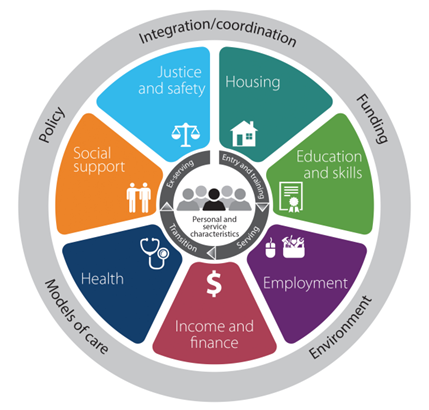AIHW-DVA Strategic Partnership
In 2017 the Department of Veterans’ Affairs (DVA) and the Australian Institute of Health and Welfare (AIHW) established a strategic partnership to implement the Veterans’ Health and Welfare: whole-of-population approach program of work (the Work Program).
Partnership aims
The overarching aim of the partnership is to develop a comprehensive profile of the health and welfare of Australia’s veteran population. It continues to take a coordinated, whole of-population approach to monitoring and reporting on health and welfare outcomes of veterans and their families, in support of and to inform DVA’s strategic, research, data and policy needs.
The work program rests on the foundational pillars of:
- comparing characteristics of veterans to the Australian general population (or a sub-population to inform appropriate evaluation of the veteran population), and
- understanding the needs of the whole veteran population including those who are not DVA clients (these are estimated to make up about 80% of the whole veteran population).
Partnership themes
The work program is designed around four broad themes that aim to better understand the health and welfare of Australia’s veterans:
- Governance & relationships: centralised hosting and access to data created for and/or by DVA veterans’ research projects, and engaging with DVA and other external stakeholders about research priorities
- Infrastructure: build consolidated, consistent data and analysis methodology as a foundation for veterans’ wellbeing research
- Data integration: use of linkage to increase opportunities to gain insights and make connections
- Data discovery: investigate survey data with veterans indicators and explore opportunities for surveys to include veterans indicators.
The Veteran-centred model
As part of the strategic partnership between DVA and AIHW, the Veteran-centred model was developed in 2018 and supports the person-centred approach to understanding the experiences and outcomes of Australian’s veterans and their families.
The Veteran-centred model (Figure 1) contains seven domains which provide a structure for organising the elements of veterans’ health and welfare and allows for exploration of the interactions between domains, the influence of individual and societal factors, and identification of those in greater need of health and welfare services.
Figure 1: Veteran-centred model

The veteran, at the centre of the model, has certain personal and service characteristics.
- Personal characteristics, such as age, sex and place of residence, are common to both veterans and the general population.
- Service characteristics are specific to the Australian veteran population (for example, type of service, conflict/trauma experience, rank, reason for separation, length of service), which may present both protective and risk factors to a veteran’s health and welfare.
The inner grey ring in Figure 1 illustrates four broad stages of the veteran lifecycle, which follows the journey of entry and training upon commencement, serving, transition to civilian life, and life as an ex-serving ADF member. Veterans needs and the relative importance of each of the domains will change as the veteran progresses through each of these stages.
By comparison, the outer grey ring depicts external factors, which include:
- Physical, sociocultural and socioeconomic environments
- Funding of programs and services available to veterans
- Models of care through the Department of Defence, DVA and mainstream services
- Government policies and legislation that affect veterans and the general population
- Integration and coordination of government policy, services and programs, and how they affect the delivery of support to veterans.
The AIHW and DVA have used this model to inform the veterans analysis work program.
More information on the veteran-centred model is available from the Development of a veteran-centred model: a working paper.


